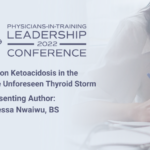Abstract | April 6, 2022
Anchoring on Ketoacidosis in the presence of the Unforeseen Thyroid Storm
Learning Objectives
- TSH and T4 levels should not be overlooked in patients presenting with diabetic ketoacidosis. Early suspicion of concomitant thyroid storm in the setting of DKA would lead to expedited treatment and improved survival.
Both thyroid storm and DKA are critical sequelae of typically benign underlying conditions when there is medical compliance and appropriate follow-up with healthcare providers. However, these conditions often involve precipitating events that spark the onset of both a thyroid storm and DKA.
We report an obscure/unusual presentation of a thyroid storm in a 31-year-old African-American female with a past medical history of insulin-dependent diabetes who presented with abdominal pain, high fever, tachycardia, and elevated glucose. She had been experiencing nausea, vomiting, abdominal pain, fever, and chills in the 24 hours prior to presentation. Physical exam findings were positive for CVA tenderness on the right flank. In this patient, it is easy to isolate pyelonephritis as the precipitating condition that initiated the primary physiologic stress response. Presumably, her acute illness of pyelonephritis was the first event that ultimately led to her status of DKA. Compensatory mechanisms to DKA from a subsequent cascade of cortisol and catecholamine release, combined with the rapid underlying metabolic shift that occurred in this patient likely served as the inciting factors to send her into a thyroid storm.
The patient’s thyroid storm was successfully treated with beta blockers, methimazole, propylthiouracil, hydrocortisone, and potassium iodide. TSH and T4 levels should not be overlooked in patients presenting with diabetic ketoacidosis. Early suspicion of concomitant thyroid storm in the setting of DKA would lead to expedited treatment and improved survival.

